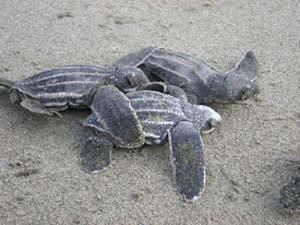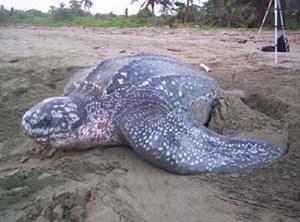Laura del Pilar Echeverri García
This project aims to continue with nesting females monitoring and with the protection program that local community develops at La Playona (Chocó, Colombia) 15 years ago, and evaluate the effect of clutches relocation in incubation period temperature and survival of hatchling.

At La Playona beach, the main documented threat to Dermochelys coriacea is excessive predation of eggs by domestic animals as much as by local people, reaching up to 100% nests loss. Because of this threat, since 1993, it has gone consolidating a monitoring program of D. coriacea nesting activity. This program has been developed mainly by the community, with occasional help from others organizations and the voluntary support of civil society. This proposal has originated with the aim to continue contributing to the monitoring activities which consist in the variables recording related to the reproductive ecology of females and nests protection in situ and in hatcheries.

This year, we have been performing national and international announcements for volunteer participation to support the monitoring of the D. coriacea nesting and hatching. We had performed a selection, organization and guidance of volunteers.
At La Playona, we are going to patrol three kilometres from the beach (those with higher volume of nesting females in last seasons) to locate females and nests for a period of 6 months. Measures shell, date, kilometre, zone of the beach, and number of fertile and infertile eggs, are going to be taken when a patrol finds a female. We are going to tag females.
Then, we are going to protect nests in situ, and those which are in risk are going to be moved to hatcheries. We must identify each nest with a unique serial number, record the nesting details, the oviposition and expected hatching dates. The temperature in 5 artificial and 5 natural nests is going to be recorded to evaluate the relocation effect on incubation temperature.
We are going to count hatchlings emerging from each nest and we are going to take 10 random samples for each nest, to record weight and measures of straight length and width of the shell. After the measurements we must release neonates in different sectors of the beach to reduce the predation. Finally we are going to exhume nests to study their contents, and to examine the causes of embryos death and to estimate the emergence and survival rates.
Additionally we are going to continue with the volunteer program that we coordinate since last year. Also we are going to develop environmental workshops in Caleta School located in Caleta's town, it is recognized for the eggs harvesting done by the native people during nesting season.